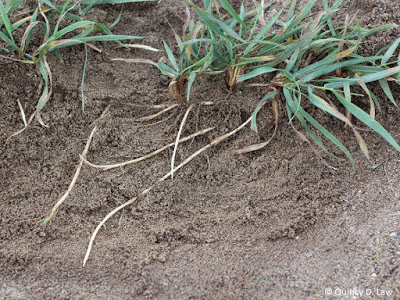Quackgrass
Biology: Quackgrass ( Elymus repens) is a cool-season perennial that vigorously spreads by rhizomes. It is a sod-forming grass that can crowd out desirable grasses and even other weeds. Quackgrass has been shown to be allelopathic, which means it releases chemicals that inhibit the growth of other plants. Large, nearly pure patches of quackgrass are able to form due to the invasive nature, extensive rhizome production and spread, and allelopathy of the species. These patches stand out in a lawn due to the ashy, blue-green color of quackgrass.
 |
| A clasping auricle is a classic quackgrass identification feature. |
 |
| A large patch of quackgrass without weeds like the surrounding turf demonstrates the allelopathic effect of quackgrass. |
Identification: The most distinct identification feature of quackgrass is its clasping auricles. Quackgrass can be distinguished from
annual ryegrass (
Lolium multiflorum) with the presence of rhizomes (i.e. quackgrass has rhizomes and annual ryegrass does not). Quackgrass has rolled vernation and a short, membranous ligule. Lower sheaths are often hairy while upper sheaths are usually smooth. Leaves are an ashy, blue-green color and can sometimes have a longitudinal twist.
 |
| Quackgrass |
 |
| Quackgrass clasping auricle. From my experience, quackgrass sheaths can be both smooth or ahiry as is this one. My observation is that the hair stem types vary throughout the season with hairs visible in spring but often absent in summer. |
 |
| Notice the leaf curling (longitudinal twist). |
 |
| If the grass has clasping auricles and rhizomes (shown here) then there are few other options and a confident diagnosis of quackgrass can be made. |
 |
| Quackgrass (wide bladed grass) in a high quality lawn. |
 |
| Patch of quackgrass (center) in a lawn. |
 |
| Tall quackgrass pictured right spreading into a lawn. |
Cultural control: A dense, healthy lawn is the best first defense against quackgrass, as it is with most weeds. Soil disturbance near a quackgrass patch can assist in the propagation and spread of quackgrass resulting from chopped rhizomes, so practices such as tillage can escalate a quackgrass problem. When reestablishing a turf sward with previous quackgrass issues, laying sod may be a better alternative to seeding because the rhizomes will have a more difficult time surfacing.
Biological control: There are currently no known biological control options for quackgrass control.
Chemical control: Unfortunately, only nonselective control options exist for quackgrass control in cool-season turf. Spot-treating with a nonselective systemic herbicide such as glyphosate (Roundup) will help to manage quackgrass in cool-season lawns. Results are best when applications are made while the weedy plants are young, fully green, actively growing, and not under drought stress. At least two glyphosate applications are recommended, but three or more may be needed since this is a rhizomatous grass. You must allow the weed to regrow before making a follow-up application.
Aaron Patton, Turfgrass Extension Specialist, Purdue University